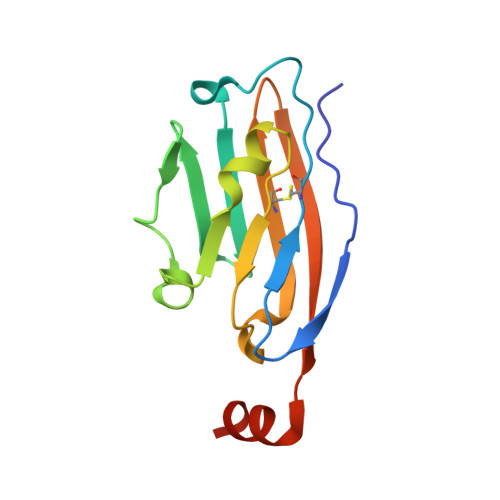Discovery and Crystallography Study of Novel Biphenyl Ether and Oxadiazole Thioether (Non-Arylmethylamine)-Based Small-Molecule PD-1/PD-L1 Inhibitors as Immunotherapeutic Agents.
Liu, J., Cheng, Y., Yuan, L., Liu, T., Ruan, Y., Ren, Y., Li, L., Jiang, S., Xiao, Y., Chen, J.(2023) J Med Chem 66: 13172-13188
- PubMed: 37674362
- DOI: https://doi.org/10.1021/acs.jmedchem.3c01141
- Primary Citation of Related Structures:
8JBA - PubMed Abstract:
Current small-molecule PD-1/PD-L1 inhibitors are mainly based on the arylmethylamine/biphenyl core scaffold. Herein, we designed for the first time a series of non-arylmethylamine analogues (oxadiazole thioether derivatives) as small-molecule PD-1/PD-L1 inhibitors. Among them, compound LP23 exhibited the most potent PD-L1 inhibitory activity with an IC 50 of 16.7 nM, 3.2-fold better than the lead BMS-202 (IC 50 = 53.6 nM). The X-ray crystal structure of LP23 in complex with PD-L1 was solved at a resolution of 2.6 Å, which further confirmed the high binding affinity of LP23 to PD-L1. In the HepG2/Jurkat T cell co-culture model, LP23 effectively promoted HepG2 cell death by restoring the immune function of T cells. In addition, LP23 showed excellent in vivo antitumor efficacy (TGI = 88.6% at 30 mg/kg) and benign toxicity profiles in a B16-F10 tumor model by modulating PD-L1. In summary, LP23 represents the first non-arylmethylamine-based small-molecule PD-1/PD-L1 inhibitor worthy of further investigation.
Organizational Affiliation:
School of Pharmaceutical Sciences, Guangdong Provincial Key Laboratory of New Drug Screening, Southern Medical University, Guangzhou 510515, China.















